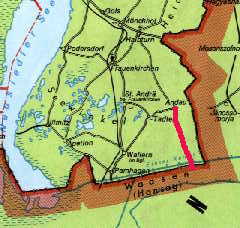
The hope for a change of the Stalinistic system let the protest movement grow rapidly.
On 23rd October, 100,000 people in Budapest demostrated against the Stalinistic leaderschip to get national souvereignity.
That meant to reduce the Soviet influence on the Hungarian politics, the marching off the Soviet army, for democratic and economic reforms and free elections; besides that the Hungarians demanded to set free political prisoners and to do away with censorship.
Thousands of demonstrators laid siege to the broadcasting corporation. They also pulled down a Stalin figure "the symbol of dictatorship" from the socket and dragged the head along the roads of the capital. That led to gunshots between security police and rebels. Some army units joined the rebels and finally the "Red Army" stepped in. When the fights were at the top the Soviet army units were removed from Budapest again. During the night from 24th October, Imre Nagy, a very popular man in Hungary, was exclaimend to be prime minister and Janos Kadar the new General Secretary of the party to calm down the minds.
The spirit of rthe rebellion went on. The demand of removing the Soviet troups grew louder and louder.
Jurij Andropow, the Soviet ambassador in Hungary, signalled the readiness of the USSR to take off their soldiers, but all in all he kept awaiting. The same time Soviet troups at the Russian& - Hungarian borderline and in the rebelling country itself were reinforced.
Nagy, frankly backed the rebels, who had already taken over the power in some towns. On 1st November, he declared the leaving from the "Warsaw Pact" and the neutrality of Hungary.
On 4th November, Kadar, who had broken with nahy in the meantime and had started negotiations with Moscow, formed a counter government. The very same day Soviet tank units advanced to Budapest, and on 7th November the rebellion had been depressed brutally.
About 25,000 Hungarians were killed - 2,000 condemned to death - and 20,000 were imprisoned.
About 200,000 escaped to the "West", which particularely meant Austria.
In the summer of 1956, before the political unrests started in Budapest, the first refuges crossed the border between Hungary and the Burgenland. The following months the stream of people swelled and swelled steadily.
Near the village of Andau, where the "Einserkanal" forms the borderline, 70,000 Hungarians fled to Austria.
They used a narrow wooden bridge known as "The Bridge at Andau" which even gained literary honours.
There was a Brigde at Andau, and if a Hungarian could reach that bridge, he was nearly free. It wasn`t much, as bridges go - not wide enough for a car, nor sturdy enough to bear a motorcycle. It was a footbridge made of rickety boards with a handrailing which little children could not quite reach. Nevertheless it was known as "The Bridge at Andau" in all of Hungary and thousands of people were heading towards the bridge.
Later, exhausted refugees had to walk 9km from the "Einserkanal" to the village of Andau. The helpfullness of the people of Andau was immense although they did not live in prosperity in 1956.
A former refugee, ex-soldier and revolutionary reports on his flight - "Friends drew a flight map for me and showed me the way across the Einserkanal to Andau. When we arrived there, we felt as though we were in paradise. We were received as if we were awaited brothers."
In the afternoon of 21st November 1956, the wooden bridge had been blown up by Hungarian border soldiers.
Forty years later, Hungarian and Austrian soldiers rebuildt, in teamwork, the new "Bridge at Andau" as a memorial.
Flightroad is a nine kilometre long Open Air Gallery. If you visit Andau (Burgenland/Austria) for an outing in the National Park "Handag/Waasen" you can see 90 sculptures put up along the road on both sides.

That path was the road to "freedom" for thousands of Hungarian people who were able to cross the historical Bridge at Andau over the "Einserkanal" as their last way out.
Artists have made it an "open air gallery" on both the Austrian and Hungarian side of the channel.